Diabetes Mellitus: Progression to Microvascular and Macrovascular Complications
VerifiedAdded on 2022/11/25
|16
|4593
|186
AI Summary
This essay assignment discusses the progression of diabetes mellitus to microvascular and macrovascular complications. It covers the pathophysiology, risk factors, prevention, and diagnosis of these complications. The essay is organized into three sections, focusing on the harm caused by prolonged hyperglycemia, atherosclerosis as a macrovascular complication, and nephropathy as a microvascular complication.
Contribute Materials
Your contribution can guide someone’s learning journey. Share your
documents today.

Nursing ;
Institutional:
Institutional:
Secure Best Marks with AI Grader
Need help grading? Try our AI Grader for instant feedback on your assignments.
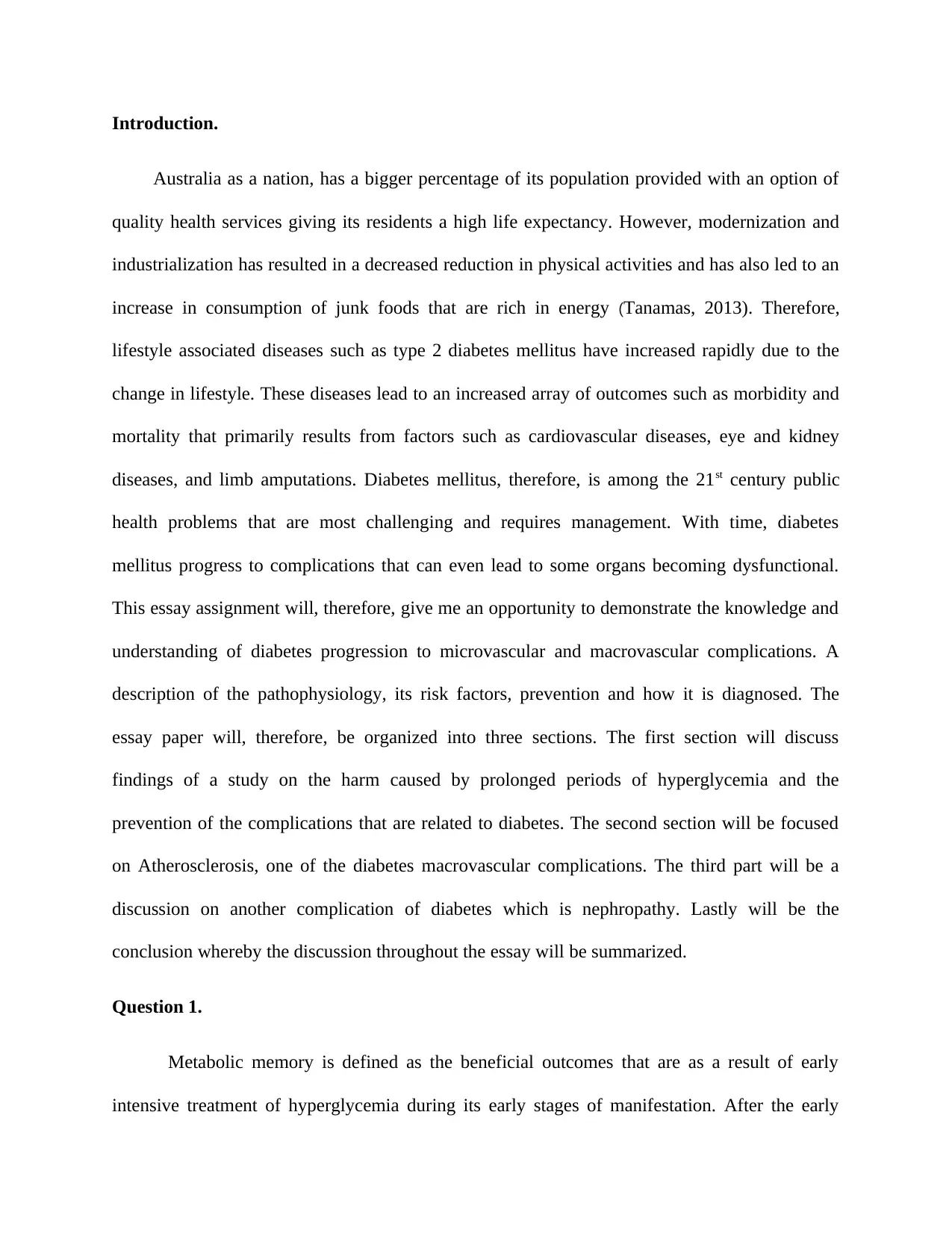
Introduction.
Australia as a nation, has a bigger percentage of its population provided with an option of
quality health services giving its residents a high life expectancy. However, modernization and
industrialization has resulted in a decreased reduction in physical activities and has also led to an
increase in consumption of junk foods that are rich in energy (Tanamas, 2013). Therefore,
lifestyle associated diseases such as type 2 diabetes mellitus have increased rapidly due to the
change in lifestyle. These diseases lead to an increased array of outcomes such as morbidity and
mortality that primarily results from factors such as cardiovascular diseases, eye and kidney
diseases, and limb amputations. Diabetes mellitus, therefore, is among the 21st century public
health problems that are most challenging and requires management. With time, diabetes
mellitus progress to complications that can even lead to some organs becoming dysfunctional.
This essay assignment will, therefore, give me an opportunity to demonstrate the knowledge and
understanding of diabetes progression to microvascular and macrovascular complications. A
description of the pathophysiology, its risk factors, prevention and how it is diagnosed. The
essay paper will, therefore, be organized into three sections. The first section will discuss
findings of a study on the harm caused by prolonged periods of hyperglycemia and the
prevention of the complications that are related to diabetes. The second section will be focused
on Atherosclerosis, one of the diabetes macrovascular complications. The third part will be a
discussion on another complication of diabetes which is nephropathy. Lastly will be the
conclusion whereby the discussion throughout the essay will be summarized.
Question 1.
Metabolic memory is defined as the beneficial outcomes that are as a result of early
intensive treatment of hyperglycemia during its early stages of manifestation. After the early
Australia as a nation, has a bigger percentage of its population provided with an option of
quality health services giving its residents a high life expectancy. However, modernization and
industrialization has resulted in a decreased reduction in physical activities and has also led to an
increase in consumption of junk foods that are rich in energy (Tanamas, 2013). Therefore,
lifestyle associated diseases such as type 2 diabetes mellitus have increased rapidly due to the
change in lifestyle. These diseases lead to an increased array of outcomes such as morbidity and
mortality that primarily results from factors such as cardiovascular diseases, eye and kidney
diseases, and limb amputations. Diabetes mellitus, therefore, is among the 21st century public
health problems that are most challenging and requires management. With time, diabetes
mellitus progress to complications that can even lead to some organs becoming dysfunctional.
This essay assignment will, therefore, give me an opportunity to demonstrate the knowledge and
understanding of diabetes progression to microvascular and macrovascular complications. A
description of the pathophysiology, its risk factors, prevention and how it is diagnosed. The
essay paper will, therefore, be organized into three sections. The first section will discuss
findings of a study on the harm caused by prolonged periods of hyperglycemia and the
prevention of the complications that are related to diabetes. The second section will be focused
on Atherosclerosis, one of the diabetes macrovascular complications. The third part will be a
discussion on another complication of diabetes which is nephropathy. Lastly will be the
conclusion whereby the discussion throughout the essay will be summarized.
Question 1.
Metabolic memory is defined as the beneficial outcomes that are as a result of early
intensive treatment of hyperglycemia during its early stages of manifestation. After the early
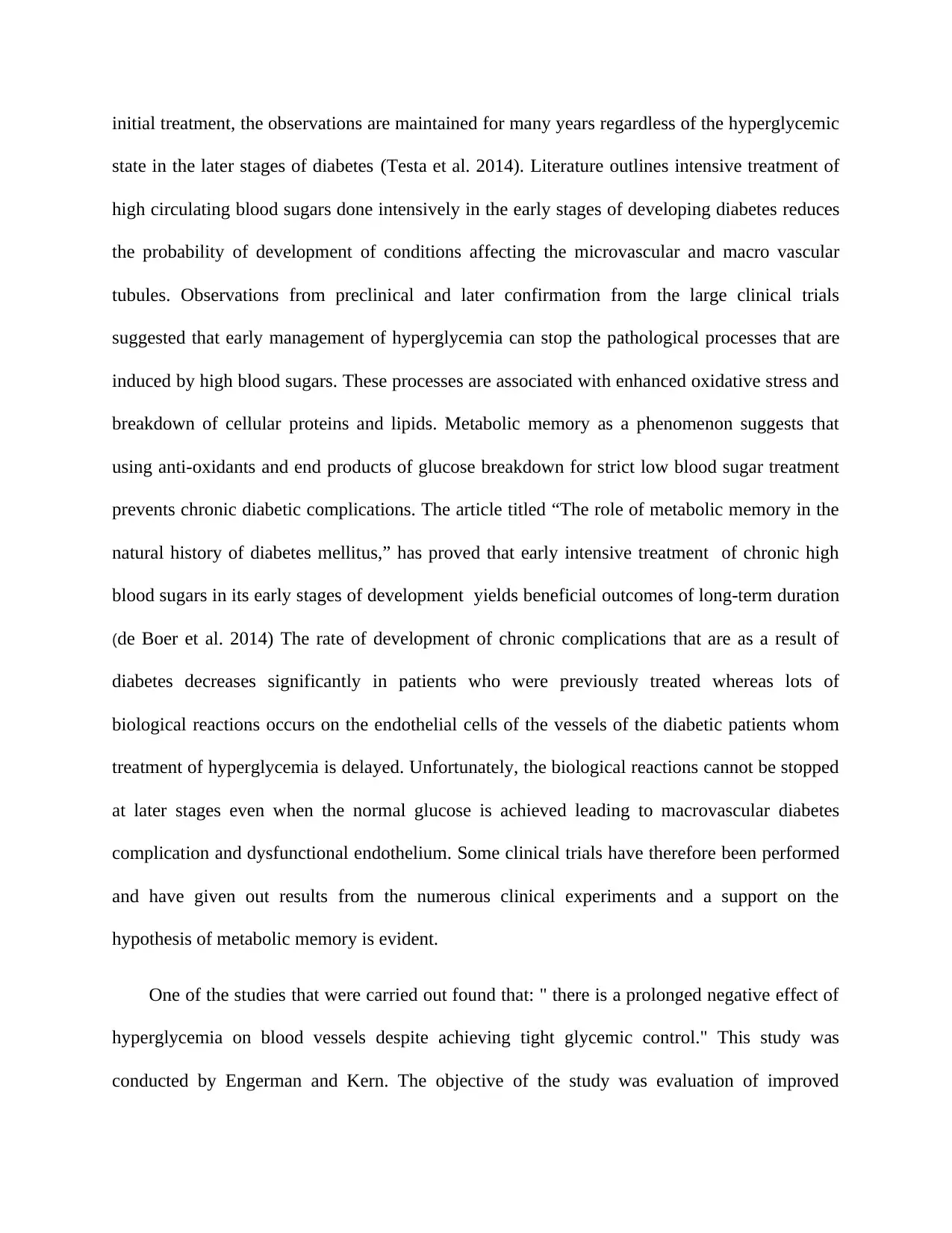
initial treatment, the observations are maintained for many years regardless of the hyperglycemic
state in the later stages of diabetes (Testa et al. 2014). Literature outlines intensive treatment of
high circulating blood sugars done intensively in the early stages of developing diabetes reduces
the probability of development of conditions affecting the microvascular and macro vascular
tubules. Observations from preclinical and later confirmation from the large clinical trials
suggested that early management of hyperglycemia can stop the pathological processes that are
induced by high blood sugars. These processes are associated with enhanced oxidative stress and
breakdown of cellular proteins and lipids. Metabolic memory as a phenomenon suggests that
using anti-oxidants and end products of glucose breakdown for strict low blood sugar treatment
prevents chronic diabetic complications. The article titled “The role of metabolic memory in the
natural history of diabetes mellitus,” has proved that early intensive treatment of chronic high
blood sugars in its early stages of development yields beneficial outcomes of long-term duration
(de Boer et al. 2014) The rate of development of chronic complications that are as a result of
diabetes decreases significantly in patients who were previously treated whereas lots of
biological reactions occurs on the endothelial cells of the vessels of the diabetic patients whom
treatment of hyperglycemia is delayed. Unfortunately, the biological reactions cannot be stopped
at later stages even when the normal glucose is achieved leading to macrovascular diabetes
complication and dysfunctional endothelium. Some clinical trials have therefore been performed
and have given out results from the numerous clinical experiments and a support on the
hypothesis of metabolic memory is evident.
One of the studies that were carried out found that: " there is a prolonged negative effect of
hyperglycemia on blood vessels despite achieving tight glycemic control." This study was
conducted by Engerman and Kern. The objective of the study was evaluation of improved
state in the later stages of diabetes (Testa et al. 2014). Literature outlines intensive treatment of
high circulating blood sugars done intensively in the early stages of developing diabetes reduces
the probability of development of conditions affecting the microvascular and macro vascular
tubules. Observations from preclinical and later confirmation from the large clinical trials
suggested that early management of hyperglycemia can stop the pathological processes that are
induced by high blood sugars. These processes are associated with enhanced oxidative stress and
breakdown of cellular proteins and lipids. Metabolic memory as a phenomenon suggests that
using anti-oxidants and end products of glucose breakdown for strict low blood sugar treatment
prevents chronic diabetic complications. The article titled “The role of metabolic memory in the
natural history of diabetes mellitus,” has proved that early intensive treatment of chronic high
blood sugars in its early stages of development yields beneficial outcomes of long-term duration
(de Boer et al. 2014) The rate of development of chronic complications that are as a result of
diabetes decreases significantly in patients who were previously treated whereas lots of
biological reactions occurs on the endothelial cells of the vessels of the diabetic patients whom
treatment of hyperglycemia is delayed. Unfortunately, the biological reactions cannot be stopped
at later stages even when the normal glucose is achieved leading to macrovascular diabetes
complication and dysfunctional endothelium. Some clinical trials have therefore been performed
and have given out results from the numerous clinical experiments and a support on the
hypothesis of metabolic memory is evident.
One of the studies that were carried out found that: " there is a prolonged negative effect of
hyperglycemia on blood vessels despite achieving tight glycemic control." This study was
conducted by Engerman and Kern. The objective of the study was evaluation of improved
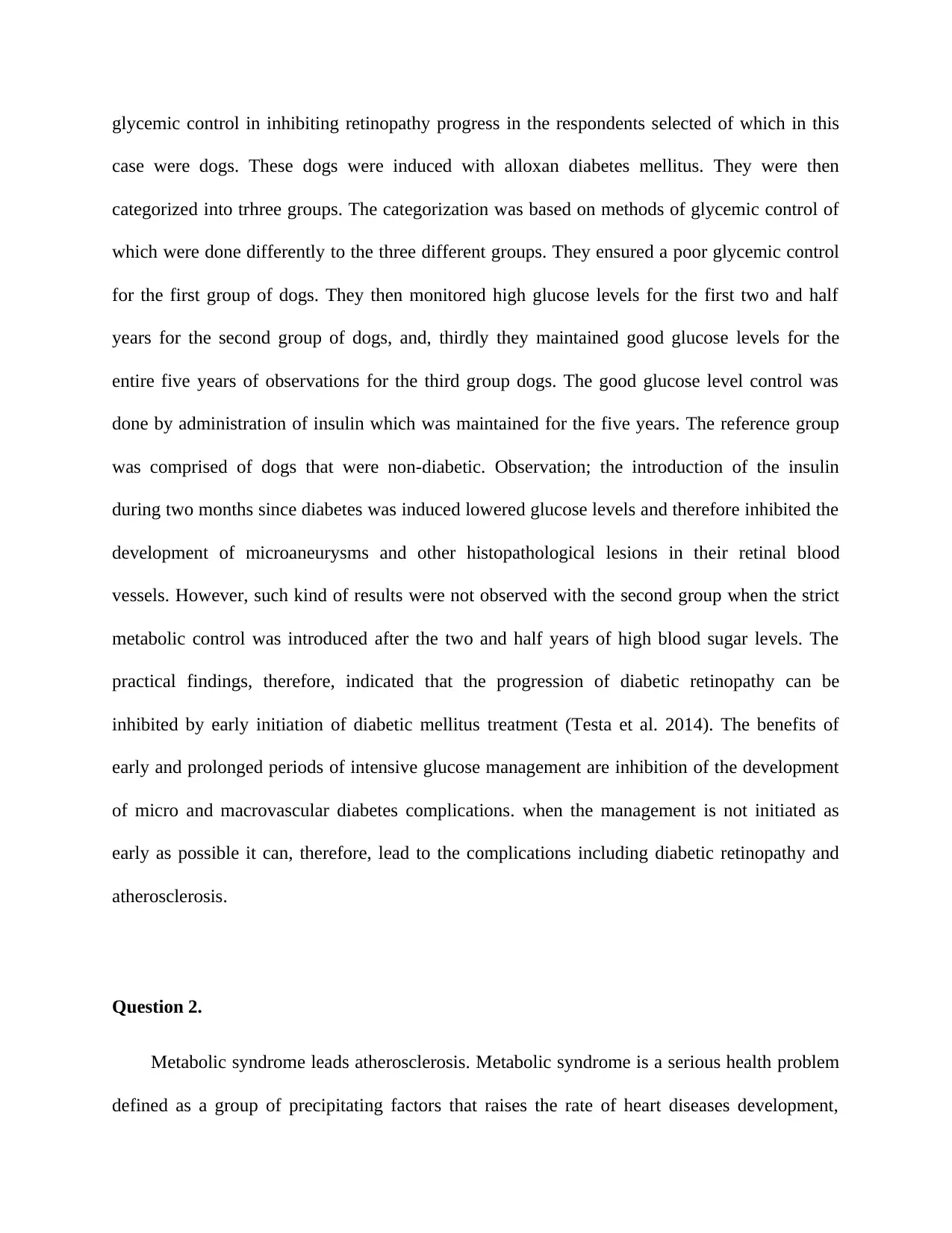
glycemic control in inhibiting retinopathy progress in the respondents selected of which in this
case were dogs. These dogs were induced with alloxan diabetes mellitus. They were then
categorized into trhree groups. The categorization was based on methods of glycemic control of
which were done differently to the three different groups. They ensured a poor glycemic control
for the first group of dogs. They then monitored high glucose levels for the first two and half
years for the second group of dogs, and, thirdly they maintained good glucose levels for the
entire five years of observations for the third group dogs. The good glucose level control was
done by administration of insulin which was maintained for the five years. The reference group
was comprised of dogs that were non-diabetic. Observation; the introduction of the insulin
during two months since diabetes was induced lowered glucose levels and therefore inhibited the
development of microaneurysms and other histopathological lesions in their retinal blood
vessels. However, such kind of results were not observed with the second group when the strict
metabolic control was introduced after the two and half years of high blood sugar levels. The
practical findings, therefore, indicated that the progression of diabetic retinopathy can be
inhibited by early initiation of diabetic mellitus treatment (Testa et al. 2014). The benefits of
early and prolonged periods of intensive glucose management are inhibition of the development
of micro and macrovascular diabetes complications. when the management is not initiated as
early as possible it can, therefore, lead to the complications including diabetic retinopathy and
atherosclerosis.
Question 2.
Metabolic syndrome leads atherosclerosis. Metabolic syndrome is a serious health problem
defined as a group of precipitating factors that raises the rate of heart diseases development,
case were dogs. These dogs were induced with alloxan diabetes mellitus. They were then
categorized into trhree groups. The categorization was based on methods of glycemic control of
which were done differently to the three different groups. They ensured a poor glycemic control
for the first group of dogs. They then monitored high glucose levels for the first two and half
years for the second group of dogs, and, thirdly they maintained good glucose levels for the
entire five years of observations for the third group dogs. The good glucose level control was
done by administration of insulin which was maintained for the five years. The reference group
was comprised of dogs that were non-diabetic. Observation; the introduction of the insulin
during two months since diabetes was induced lowered glucose levels and therefore inhibited the
development of microaneurysms and other histopathological lesions in their retinal blood
vessels. However, such kind of results were not observed with the second group when the strict
metabolic control was introduced after the two and half years of high blood sugar levels. The
practical findings, therefore, indicated that the progression of diabetic retinopathy can be
inhibited by early initiation of diabetic mellitus treatment (Testa et al. 2014). The benefits of
early and prolonged periods of intensive glucose management are inhibition of the development
of micro and macrovascular diabetes complications. when the management is not initiated as
early as possible it can, therefore, lead to the complications including diabetic retinopathy and
atherosclerosis.
Question 2.
Metabolic syndrome leads atherosclerosis. Metabolic syndrome is a serious health problem
defined as a group of precipitating factors that raises the rate of heart diseases development,
Secure Best Marks with AI Grader
Need help grading? Try our AI Grader for instant feedback on your assignments.
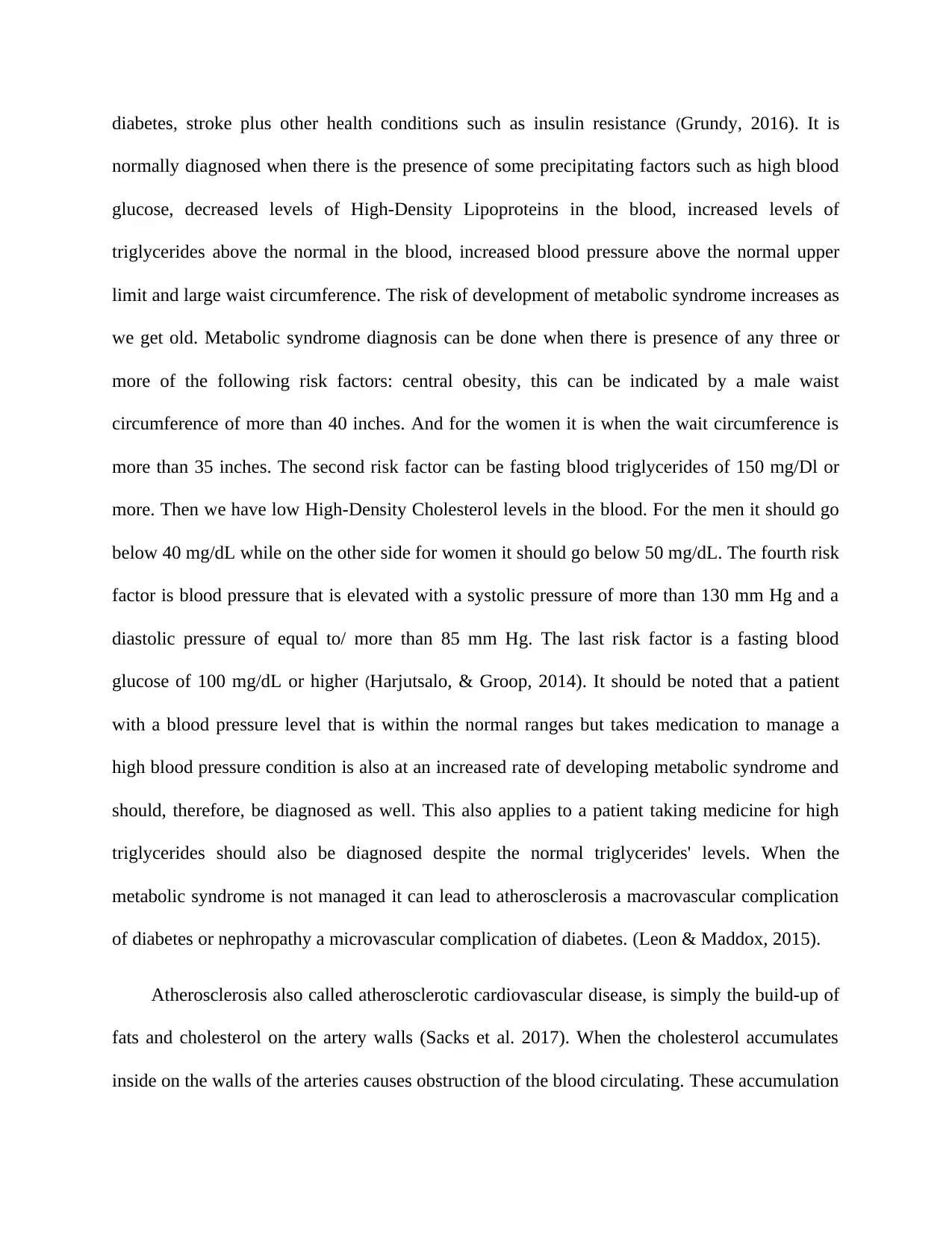
diabetes, stroke plus other health conditions such as insulin resistance (Grundy, 2016). It is
normally diagnosed when there is the presence of some precipitating factors such as high blood
glucose, decreased levels of High-Density Lipoproteins in the blood, increased levels of
triglycerides above the normal in the blood, increased blood pressure above the normal upper
limit and large waist circumference. The risk of development of metabolic syndrome increases as
we get old. Metabolic syndrome diagnosis can be done when there is presence of any three or
more of the following risk factors: central obesity, this can be indicated by a male waist
circumference of more than 40 inches. And for the women it is when the wait circumference is
more than 35 inches. The second risk factor can be fasting blood triglycerides of 150 mg/Dl or
more. Then we have low High-Density Cholesterol levels in the blood. For the men it should go
below 40 mg/dL while on the other side for women it should go below 50 mg/dL. The fourth risk
factor is blood pressure that is elevated with a systolic pressure of more than 130 mm Hg and a
diastolic pressure of equal to/ more than 85 mm Hg. The last risk factor is a fasting blood
glucose of 100 mg/dL or higher (Harjutsalo, & Groop, 2014). It should be noted that a patient
with a blood pressure level that is within the normal ranges but takes medication to manage a
high blood pressure condition is also at an increased rate of developing metabolic syndrome and
should, therefore, be diagnosed as well. This also applies to a patient taking medicine for high
triglycerides should also be diagnosed despite the normal triglycerides' levels. When the
metabolic syndrome is not managed it can lead to atherosclerosis a macrovascular complication
of diabetes or nephropathy a microvascular complication of diabetes. (Leon & Maddox, 2015).
Atherosclerosis also called atherosclerotic cardiovascular disease, is simply the build-up of
fats and cholesterol on the artery walls (Sacks et al. 2017). When the cholesterol accumulates
inside on the walls of the arteries causes obstruction of the blood circulating. These accumulation
normally diagnosed when there is the presence of some precipitating factors such as high blood
glucose, decreased levels of High-Density Lipoproteins in the blood, increased levels of
triglycerides above the normal in the blood, increased blood pressure above the normal upper
limit and large waist circumference. The risk of development of metabolic syndrome increases as
we get old. Metabolic syndrome diagnosis can be done when there is presence of any three or
more of the following risk factors: central obesity, this can be indicated by a male waist
circumference of more than 40 inches. And for the women it is when the wait circumference is
more than 35 inches. The second risk factor can be fasting blood triglycerides of 150 mg/Dl or
more. Then we have low High-Density Cholesterol levels in the blood. For the men it should go
below 40 mg/dL while on the other side for women it should go below 50 mg/dL. The fourth risk
factor is blood pressure that is elevated with a systolic pressure of more than 130 mm Hg and a
diastolic pressure of equal to/ more than 85 mm Hg. The last risk factor is a fasting blood
glucose of 100 mg/dL or higher (Harjutsalo, & Groop, 2014). It should be noted that a patient
with a blood pressure level that is within the normal ranges but takes medication to manage a
high blood pressure condition is also at an increased rate of developing metabolic syndrome and
should, therefore, be diagnosed as well. This also applies to a patient taking medicine for high
triglycerides should also be diagnosed despite the normal triglycerides' levels. When the
metabolic syndrome is not managed it can lead to atherosclerosis a macrovascular complication
of diabetes or nephropathy a microvascular complication of diabetes. (Leon & Maddox, 2015).
Atherosclerosis also called atherosclerotic cardiovascular disease, is simply the build-up of
fats and cholesterol on the artery walls (Sacks et al. 2017). When the cholesterol accumulates
inside on the walls of the arteries causes obstruction of the blood circulating. These accumulation
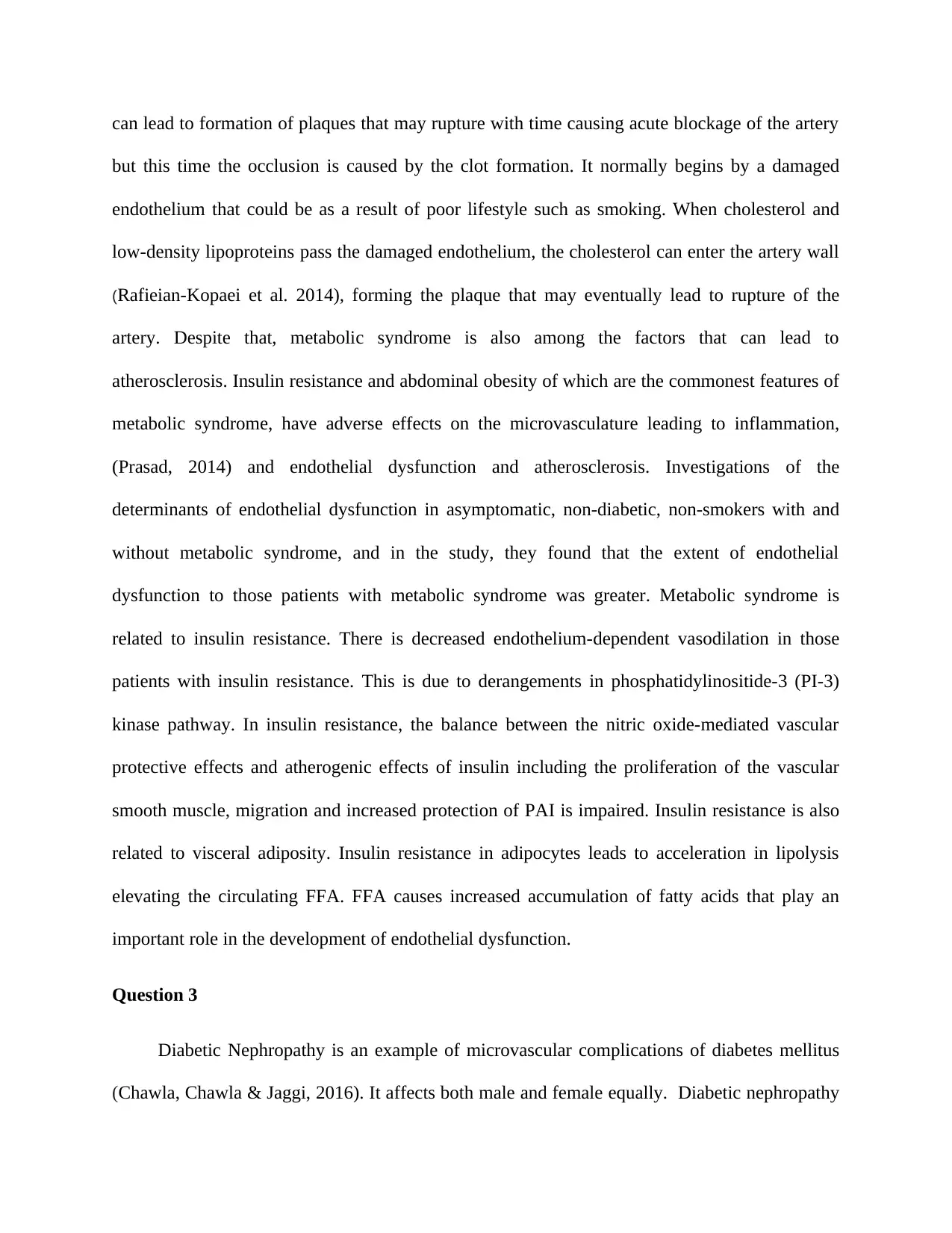
can lead to formation of plaques that may rupture with time causing acute blockage of the artery
but this time the occlusion is caused by the clot formation. It normally begins by a damaged
endothelium that could be as a result of poor lifestyle such as smoking. When cholesterol and
low-density lipoproteins pass the damaged endothelium, the cholesterol can enter the artery wall
(Rafieian-Kopaei et al. 2014), forming the plaque that may eventually lead to rupture of the
artery. Despite that, metabolic syndrome is also among the factors that can lead to
atherosclerosis. Insulin resistance and abdominal obesity of which are the commonest features of
metabolic syndrome, have adverse effects on the microvasculature leading to inflammation,
(Prasad, 2014) and endothelial dysfunction and atherosclerosis. Investigations of the
determinants of endothelial dysfunction in asymptomatic, non-diabetic, non-smokers with and
without metabolic syndrome, and in the study, they found that the extent of endothelial
dysfunction to those patients with metabolic syndrome was greater. Metabolic syndrome is
related to insulin resistance. There is decreased endothelium-dependent vasodilation in those
patients with insulin resistance. This is due to derangements in phosphatidylinositide-3 (PI-3)
kinase pathway. In insulin resistance, the balance between the nitric oxide-mediated vascular
protective effects and atherogenic effects of insulin including the proliferation of the vascular
smooth muscle, migration and increased protection of PAI is impaired. Insulin resistance is also
related to visceral adiposity. Insulin resistance in adipocytes leads to acceleration in lipolysis
elevating the circulating FFA. FFA causes increased accumulation of fatty acids that play an
important role in the development of endothelial dysfunction.
Question 3
Diabetic Nephropathy is an example of microvascular complications of diabetes mellitus
(Chawla, Chawla & Jaggi, 2016). It affects both male and female equally. Diabetic nephropathy
but this time the occlusion is caused by the clot formation. It normally begins by a damaged
endothelium that could be as a result of poor lifestyle such as smoking. When cholesterol and
low-density lipoproteins pass the damaged endothelium, the cholesterol can enter the artery wall
(Rafieian-Kopaei et al. 2014), forming the plaque that may eventually lead to rupture of the
artery. Despite that, metabolic syndrome is also among the factors that can lead to
atherosclerosis. Insulin resistance and abdominal obesity of which are the commonest features of
metabolic syndrome, have adverse effects on the microvasculature leading to inflammation,
(Prasad, 2014) and endothelial dysfunction and atherosclerosis. Investigations of the
determinants of endothelial dysfunction in asymptomatic, non-diabetic, non-smokers with and
without metabolic syndrome, and in the study, they found that the extent of endothelial
dysfunction to those patients with metabolic syndrome was greater. Metabolic syndrome is
related to insulin resistance. There is decreased endothelium-dependent vasodilation in those
patients with insulin resistance. This is due to derangements in phosphatidylinositide-3 (PI-3)
kinase pathway. In insulin resistance, the balance between the nitric oxide-mediated vascular
protective effects and atherogenic effects of insulin including the proliferation of the vascular
smooth muscle, migration and increased protection of PAI is impaired. Insulin resistance is also
related to visceral adiposity. Insulin resistance in adipocytes leads to acceleration in lipolysis
elevating the circulating FFA. FFA causes increased accumulation of fatty acids that play an
important role in the development of endothelial dysfunction.
Question 3
Diabetic Nephropathy is an example of microvascular complications of diabetes mellitus
(Chawla, Chawla & Jaggi, 2016). It affects both male and female equally. Diabetic nephropathy
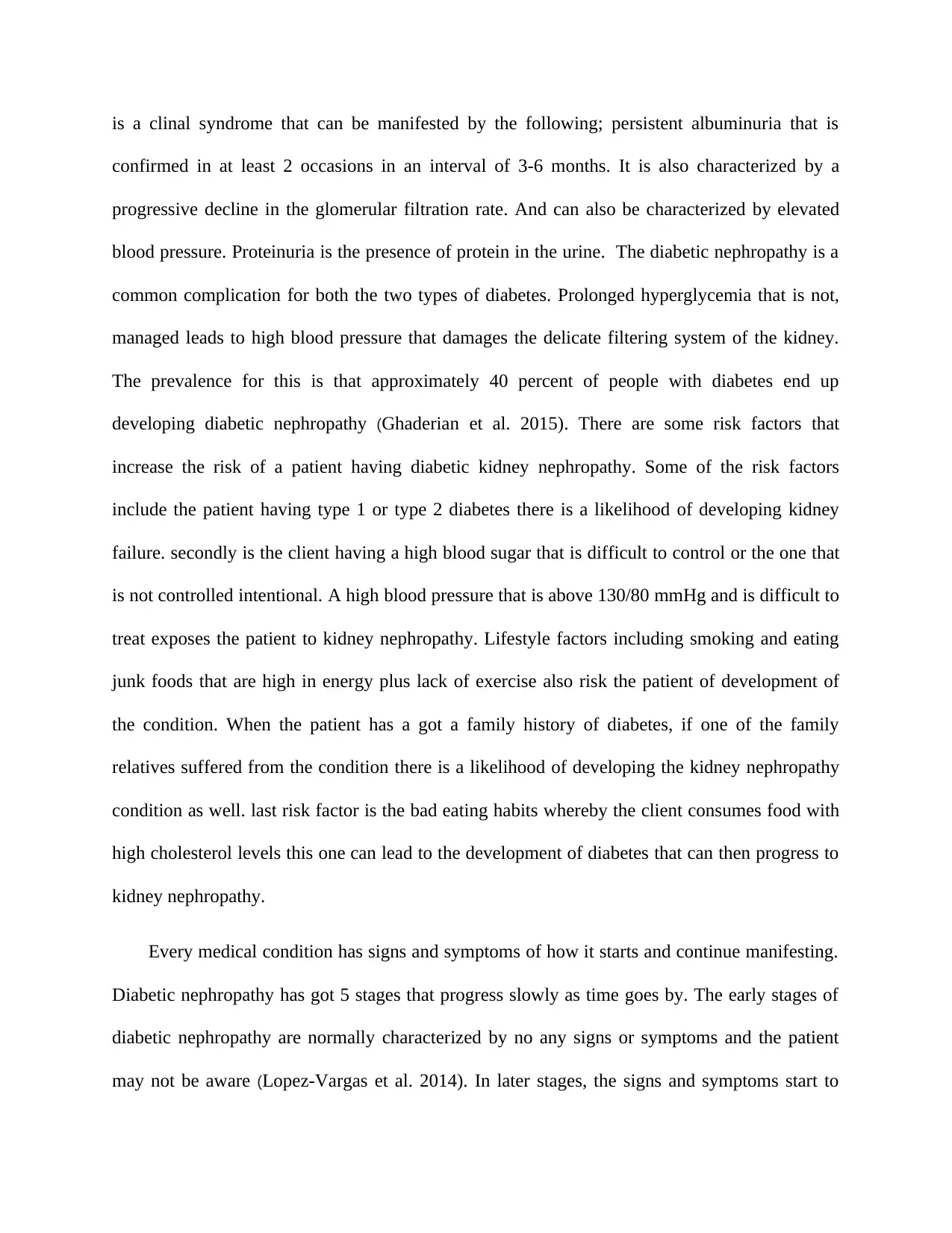
is a clinal syndrome that can be manifested by the following; persistent albuminuria that is
confirmed in at least 2 occasions in an interval of 3-6 months. It is also characterized by a
progressive decline in the glomerular filtration rate. And can also be characterized by elevated
blood pressure. Proteinuria is the presence of protein in the urine. The diabetic nephropathy is a
common complication for both the two types of diabetes. Prolonged hyperglycemia that is not,
managed leads to high blood pressure that damages the delicate filtering system of the kidney.
The prevalence for this is that approximately 40 percent of people with diabetes end up
developing diabetic nephropathy (Ghaderian et al. 2015). There are some risk factors that
increase the risk of a patient having diabetic kidney nephropathy. Some of the risk factors
include the patient having type 1 or type 2 diabetes there is a likelihood of developing kidney
failure. secondly is the client having a high blood sugar that is difficult to control or the one that
is not controlled intentional. A high blood pressure that is above 130/80 mmHg and is difficult to
treat exposes the patient to kidney nephropathy. Lifestyle factors including smoking and eating
junk foods that are high in energy plus lack of exercise also risk the patient of development of
the condition. When the patient has a got a family history of diabetes, if one of the family
relatives suffered from the condition there is a likelihood of developing the kidney nephropathy
condition as well. last risk factor is the bad eating habits whereby the client consumes food with
high cholesterol levels this one can lead to the development of diabetes that can then progress to
kidney nephropathy.
Every medical condition has signs and symptoms of how it starts and continue manifesting.
Diabetic nephropathy has got 5 stages that progress slowly as time goes by. The early stages of
diabetic nephropathy are normally characterized by no any signs or symptoms and the patient
may not be aware (Lopez‐Vargas et al. 2014). In later stages, the signs and symptoms start to
confirmed in at least 2 occasions in an interval of 3-6 months. It is also characterized by a
progressive decline in the glomerular filtration rate. And can also be characterized by elevated
blood pressure. Proteinuria is the presence of protein in the urine. The diabetic nephropathy is a
common complication for both the two types of diabetes. Prolonged hyperglycemia that is not,
managed leads to high blood pressure that damages the delicate filtering system of the kidney.
The prevalence for this is that approximately 40 percent of people with diabetes end up
developing diabetic nephropathy (Ghaderian et al. 2015). There are some risk factors that
increase the risk of a patient having diabetic kidney nephropathy. Some of the risk factors
include the patient having type 1 or type 2 diabetes there is a likelihood of developing kidney
failure. secondly is the client having a high blood sugar that is difficult to control or the one that
is not controlled intentional. A high blood pressure that is above 130/80 mmHg and is difficult to
treat exposes the patient to kidney nephropathy. Lifestyle factors including smoking and eating
junk foods that are high in energy plus lack of exercise also risk the patient of development of
the condition. When the patient has a got a family history of diabetes, if one of the family
relatives suffered from the condition there is a likelihood of developing the kidney nephropathy
condition as well. last risk factor is the bad eating habits whereby the client consumes food with
high cholesterol levels this one can lead to the development of diabetes that can then progress to
kidney nephropathy.
Every medical condition has signs and symptoms of how it starts and continue manifesting.
Diabetic nephropathy has got 5 stages that progress slowly as time goes by. The early stages of
diabetic nephropathy are normally characterized by no any signs or symptoms and the patient
may not be aware (Lopez‐Vargas et al. 2014). In later stages, the signs and symptoms start to
Paraphrase This Document
Need a fresh take? Get an instant paraphrase of this document with our AI Paraphraser
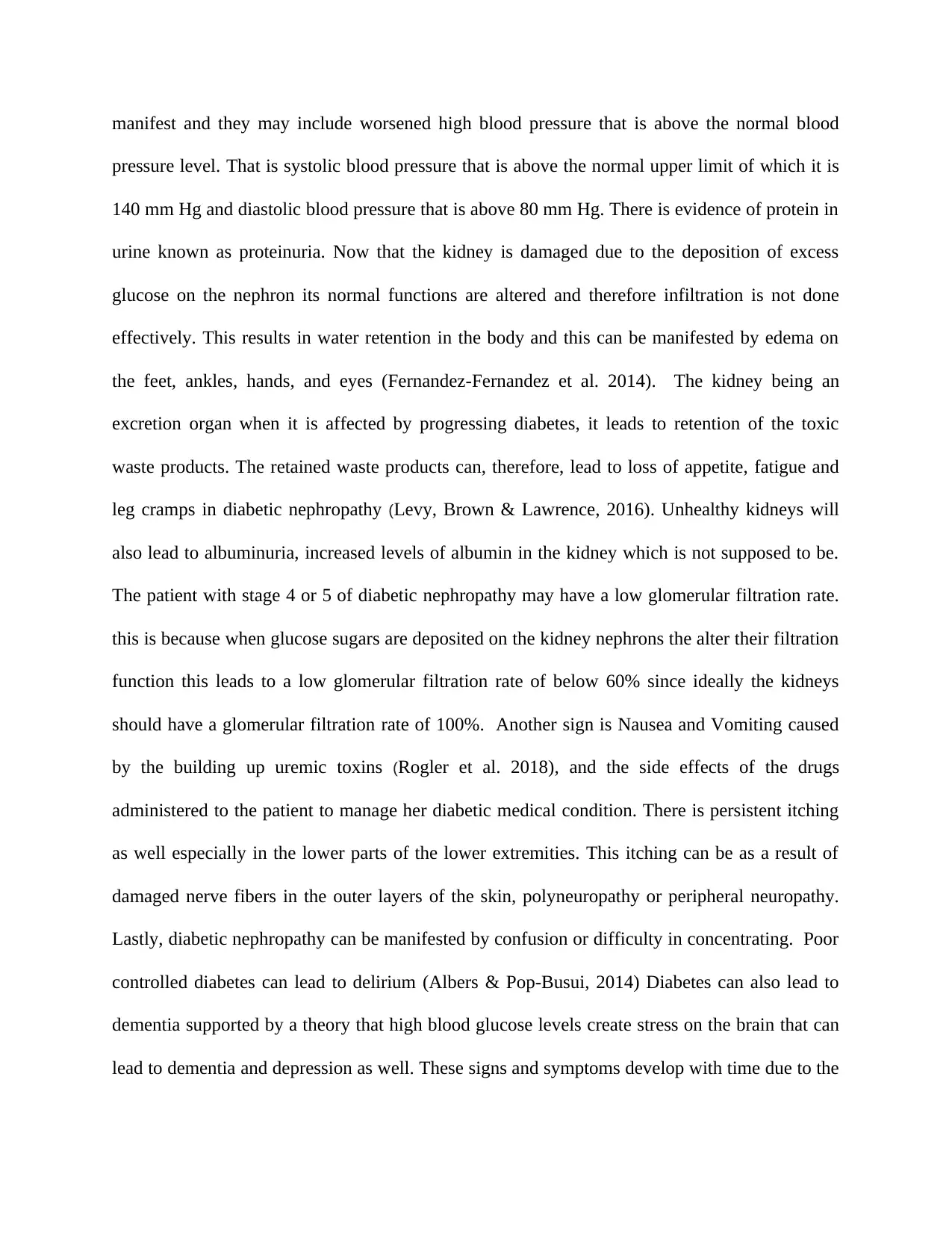
manifest and they may include worsened high blood pressure that is above the normal blood
pressure level. That is systolic blood pressure that is above the normal upper limit of which it is
140 mm Hg and diastolic blood pressure that is above 80 mm Hg. There is evidence of protein in
urine known as proteinuria. Now that the kidney is damaged due to the deposition of excess
glucose on the nephron its normal functions are altered and therefore infiltration is not done
effectively. This results in water retention in the body and this can be manifested by edema on
the feet, ankles, hands, and eyes (Fernandez-Fernandez et al. 2014). The kidney being an
excretion organ when it is affected by progressing diabetes, it leads to retention of the toxic
waste products. The retained waste products can, therefore, lead to loss of appetite, fatigue and
leg cramps in diabetic nephropathy (Levy, Brown & Lawrence, 2016). Unhealthy kidneys will
also lead to albuminuria, increased levels of albumin in the kidney which is not supposed to be.
The patient with stage 4 or 5 of diabetic nephropathy may have a low glomerular filtration rate.
this is because when glucose sugars are deposited on the kidney nephrons the alter their filtration
function this leads to a low glomerular filtration rate of below 60% since ideally the kidneys
should have a glomerular filtration rate of 100%. Another sign is Nausea and Vomiting caused
by the building up uremic toxins (Rogler et al. 2018), and the side effects of the drugs
administered to the patient to manage her diabetic medical condition. There is persistent itching
as well especially in the lower parts of the lower extremities. This itching can be as a result of
damaged nerve fibers in the outer layers of the skin, polyneuropathy or peripheral neuropathy.
Lastly, diabetic nephropathy can be manifested by confusion or difficulty in concentrating. Poor
controlled diabetes can lead to delirium (Albers & Pop-Busui, 2014) Diabetes can also lead to
dementia supported by a theory that high blood glucose levels create stress on the brain that can
lead to dementia and depression as well. These signs and symptoms develop with time due to the
pressure level. That is systolic blood pressure that is above the normal upper limit of which it is
140 mm Hg and diastolic blood pressure that is above 80 mm Hg. There is evidence of protein in
urine known as proteinuria. Now that the kidney is damaged due to the deposition of excess
glucose on the nephron its normal functions are altered and therefore infiltration is not done
effectively. This results in water retention in the body and this can be manifested by edema on
the feet, ankles, hands, and eyes (Fernandez-Fernandez et al. 2014). The kidney being an
excretion organ when it is affected by progressing diabetes, it leads to retention of the toxic
waste products. The retained waste products can, therefore, lead to loss of appetite, fatigue and
leg cramps in diabetic nephropathy (Levy, Brown & Lawrence, 2016). Unhealthy kidneys will
also lead to albuminuria, increased levels of albumin in the kidney which is not supposed to be.
The patient with stage 4 or 5 of diabetic nephropathy may have a low glomerular filtration rate.
this is because when glucose sugars are deposited on the kidney nephrons the alter their filtration
function this leads to a low glomerular filtration rate of below 60% since ideally the kidneys
should have a glomerular filtration rate of 100%. Another sign is Nausea and Vomiting caused
by the building up uremic toxins (Rogler et al. 2018), and the side effects of the drugs
administered to the patient to manage her diabetic medical condition. There is persistent itching
as well especially in the lower parts of the lower extremities. This itching can be as a result of
damaged nerve fibers in the outer layers of the skin, polyneuropathy or peripheral neuropathy.
Lastly, diabetic nephropathy can be manifested by confusion or difficulty in concentrating. Poor
controlled diabetes can lead to delirium (Albers & Pop-Busui, 2014) Diabetes can also lead to
dementia supported by a theory that high blood glucose levels create stress on the brain that can
lead to dementia and depression as well. These signs and symptoms develop with time due to the
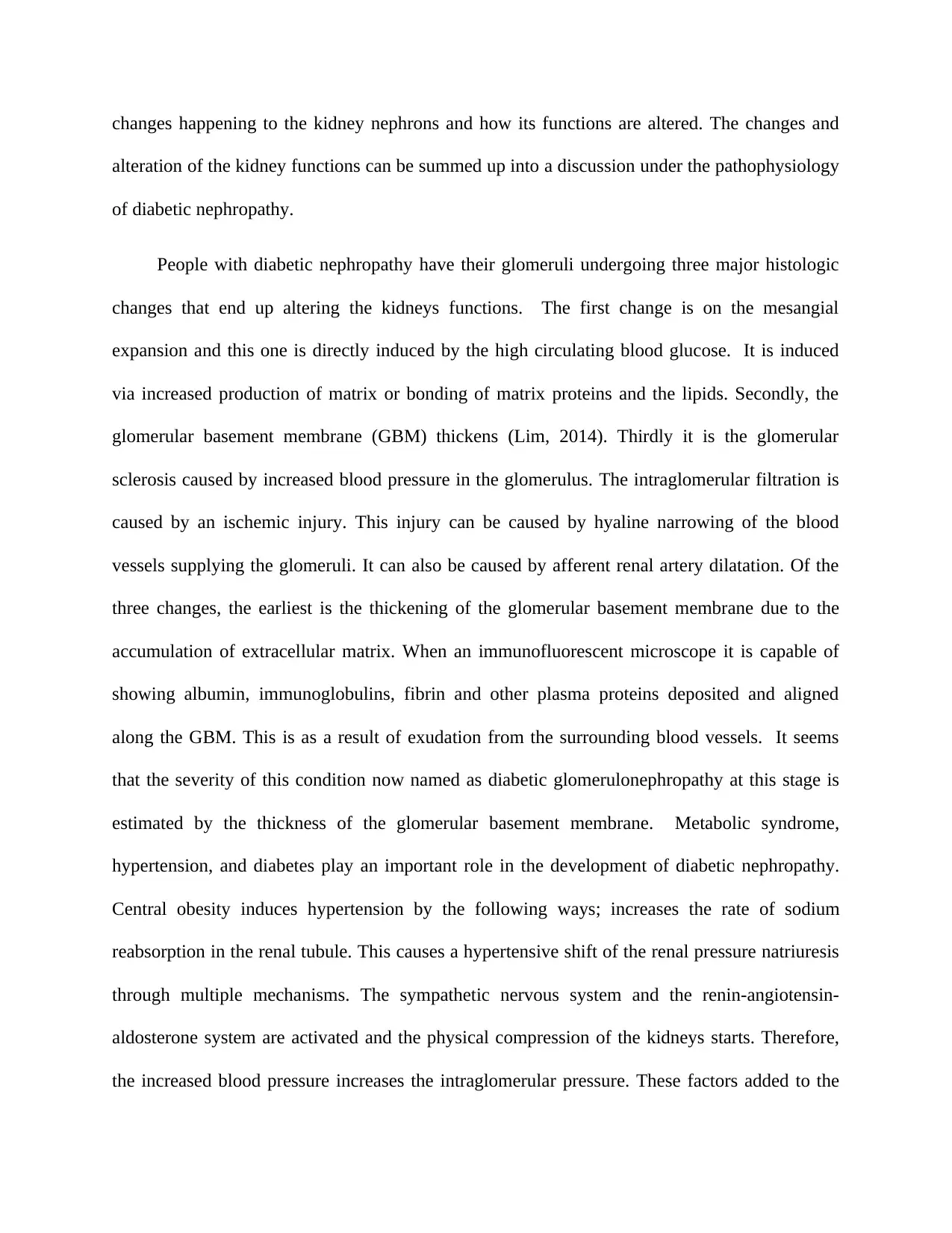
changes happening to the kidney nephrons and how its functions are altered. The changes and
alteration of the kidney functions can be summed up into a discussion under the pathophysiology
of diabetic nephropathy.
People with diabetic nephropathy have their glomeruli undergoing three major histologic
changes that end up altering the kidneys functions. The first change is on the mesangial
expansion and this one is directly induced by the high circulating blood glucose. It is induced
via increased production of matrix or bonding of matrix proteins and the lipids. Secondly, the
glomerular basement membrane (GBM) thickens (Lim, 2014). Thirdly it is the glomerular
sclerosis caused by increased blood pressure in the glomerulus. The intraglomerular filtration is
caused by an ischemic injury. This injury can be caused by hyaline narrowing of the blood
vessels supplying the glomeruli. It can also be caused by afferent renal artery dilatation. Of the
three changes, the earliest is the thickening of the glomerular basement membrane due to the
accumulation of extracellular matrix. When an immunofluorescent microscope it is capable of
showing albumin, immunoglobulins, fibrin and other plasma proteins deposited and aligned
along the GBM. This is as a result of exudation from the surrounding blood vessels. It seems
that the severity of this condition now named as diabetic glomerulonephropathy at this stage is
estimated by the thickness of the glomerular basement membrane. Metabolic syndrome,
hypertension, and diabetes play an important role in the development of diabetic nephropathy.
Central obesity induces hypertension by the following ways; increases the rate of sodium
reabsorption in the renal tubule. This causes a hypertensive shift of the renal pressure natriuresis
through multiple mechanisms. The sympathetic nervous system and the renin-angiotensin-
aldosterone system are activated and the physical compression of the kidneys starts. Therefore,
the increased blood pressure increases the intraglomerular pressure. These factors added to the
alteration of the kidney functions can be summed up into a discussion under the pathophysiology
of diabetic nephropathy.
People with diabetic nephropathy have their glomeruli undergoing three major histologic
changes that end up altering the kidneys functions. The first change is on the mesangial
expansion and this one is directly induced by the high circulating blood glucose. It is induced
via increased production of matrix or bonding of matrix proteins and the lipids. Secondly, the
glomerular basement membrane (GBM) thickens (Lim, 2014). Thirdly it is the glomerular
sclerosis caused by increased blood pressure in the glomerulus. The intraglomerular filtration is
caused by an ischemic injury. This injury can be caused by hyaline narrowing of the blood
vessels supplying the glomeruli. It can also be caused by afferent renal artery dilatation. Of the
three changes, the earliest is the thickening of the glomerular basement membrane due to the
accumulation of extracellular matrix. When an immunofluorescent microscope it is capable of
showing albumin, immunoglobulins, fibrin and other plasma proteins deposited and aligned
along the GBM. This is as a result of exudation from the surrounding blood vessels. It seems
that the severity of this condition now named as diabetic glomerulonephropathy at this stage is
estimated by the thickness of the glomerular basement membrane. Metabolic syndrome,
hypertension, and diabetes play an important role in the development of diabetic nephropathy.
Central obesity induces hypertension by the following ways; increases the rate of sodium
reabsorption in the renal tubule. This causes a hypertensive shift of the renal pressure natriuresis
through multiple mechanisms. The sympathetic nervous system and the renin-angiotensin-
aldosterone system are activated and the physical compression of the kidneys starts. Therefore,
the increased blood pressure increases the intraglomerular pressure. These factors added to the
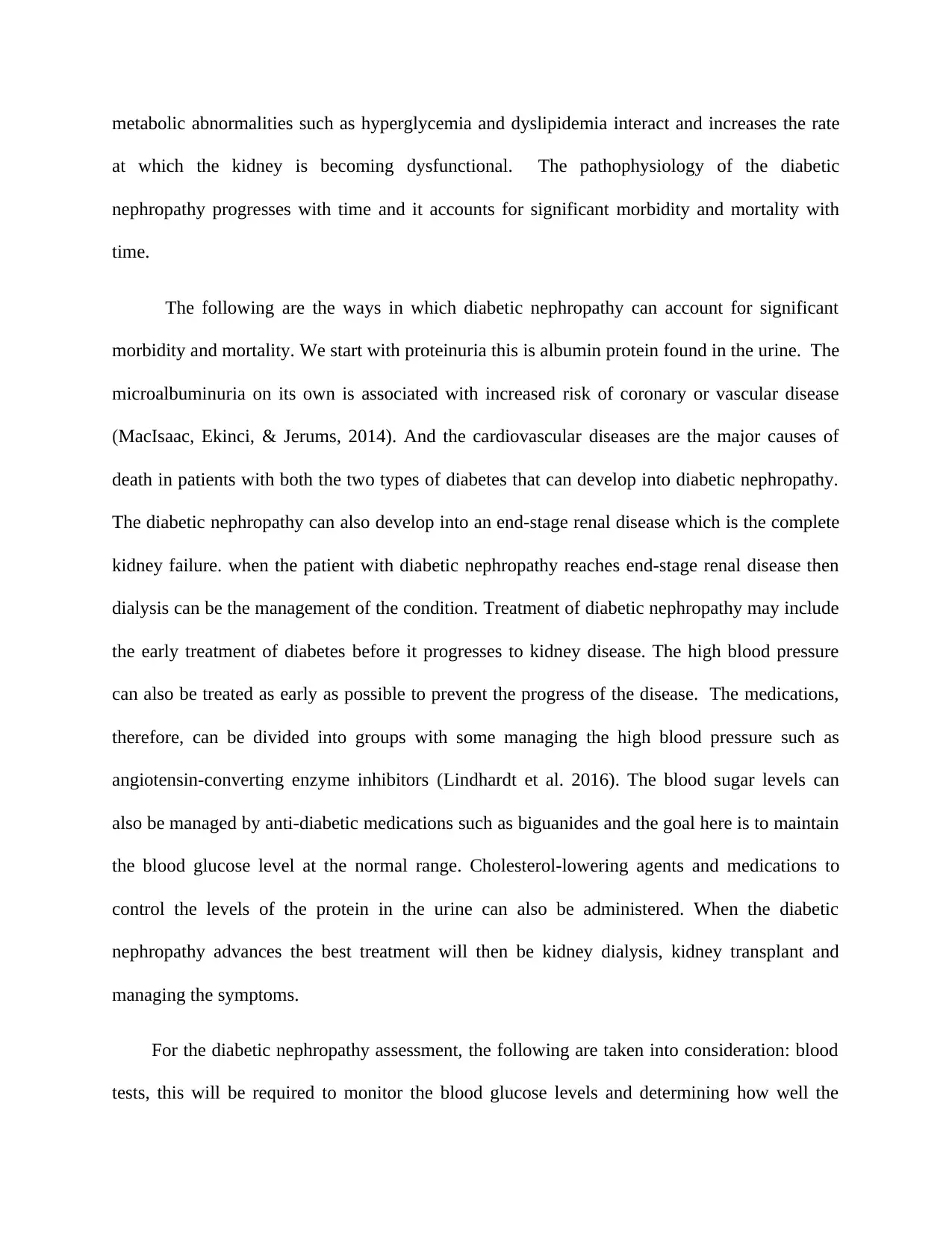
metabolic abnormalities such as hyperglycemia and dyslipidemia interact and increases the rate
at which the kidney is becoming dysfunctional. The pathophysiology of the diabetic
nephropathy progresses with time and it accounts for significant morbidity and mortality with
time.
The following are the ways in which diabetic nephropathy can account for significant
morbidity and mortality. We start with proteinuria this is albumin protein found in the urine. The
microalbuminuria on its own is associated with increased risk of coronary or vascular disease
(MacIsaac, Ekinci, & Jerums, 2014). And the cardiovascular diseases are the major causes of
death in patients with both the two types of diabetes that can develop into diabetic nephropathy.
The diabetic nephropathy can also develop into an end-stage renal disease which is the complete
kidney failure. when the patient with diabetic nephropathy reaches end-stage renal disease then
dialysis can be the management of the condition. Treatment of diabetic nephropathy may include
the early treatment of diabetes before it progresses to kidney disease. The high blood pressure
can also be treated as early as possible to prevent the progress of the disease. The medications,
therefore, can be divided into groups with some managing the high blood pressure such as
angiotensin-converting enzyme inhibitors (Lindhardt et al. 2016). The blood sugar levels can
also be managed by anti-diabetic medications such as biguanides and the goal here is to maintain
the blood glucose level at the normal range. Cholesterol-lowering agents and medications to
control the levels of the protein in the urine can also be administered. When the diabetic
nephropathy advances the best treatment will then be kidney dialysis, kidney transplant and
managing the symptoms.
For the diabetic nephropathy assessment, the following are taken into consideration: blood
tests, this will be required to monitor the blood glucose levels and determining how well the
at which the kidney is becoming dysfunctional. The pathophysiology of the diabetic
nephropathy progresses with time and it accounts for significant morbidity and mortality with
time.
The following are the ways in which diabetic nephropathy can account for significant
morbidity and mortality. We start with proteinuria this is albumin protein found in the urine. The
microalbuminuria on its own is associated with increased risk of coronary or vascular disease
(MacIsaac, Ekinci, & Jerums, 2014). And the cardiovascular diseases are the major causes of
death in patients with both the two types of diabetes that can develop into diabetic nephropathy.
The diabetic nephropathy can also develop into an end-stage renal disease which is the complete
kidney failure. when the patient with diabetic nephropathy reaches end-stage renal disease then
dialysis can be the management of the condition. Treatment of diabetic nephropathy may include
the early treatment of diabetes before it progresses to kidney disease. The high blood pressure
can also be treated as early as possible to prevent the progress of the disease. The medications,
therefore, can be divided into groups with some managing the high blood pressure such as
angiotensin-converting enzyme inhibitors (Lindhardt et al. 2016). The blood sugar levels can
also be managed by anti-diabetic medications such as biguanides and the goal here is to maintain
the blood glucose level at the normal range. Cholesterol-lowering agents and medications to
control the levels of the protein in the urine can also be administered. When the diabetic
nephropathy advances the best treatment will then be kidney dialysis, kidney transplant and
managing the symptoms.
For the diabetic nephropathy assessment, the following are taken into consideration: blood
tests, this will be required to monitor the blood glucose levels and determining how well the
Secure Best Marks with AI Grader
Need help grading? Try our AI Grader for instant feedback on your assignments.
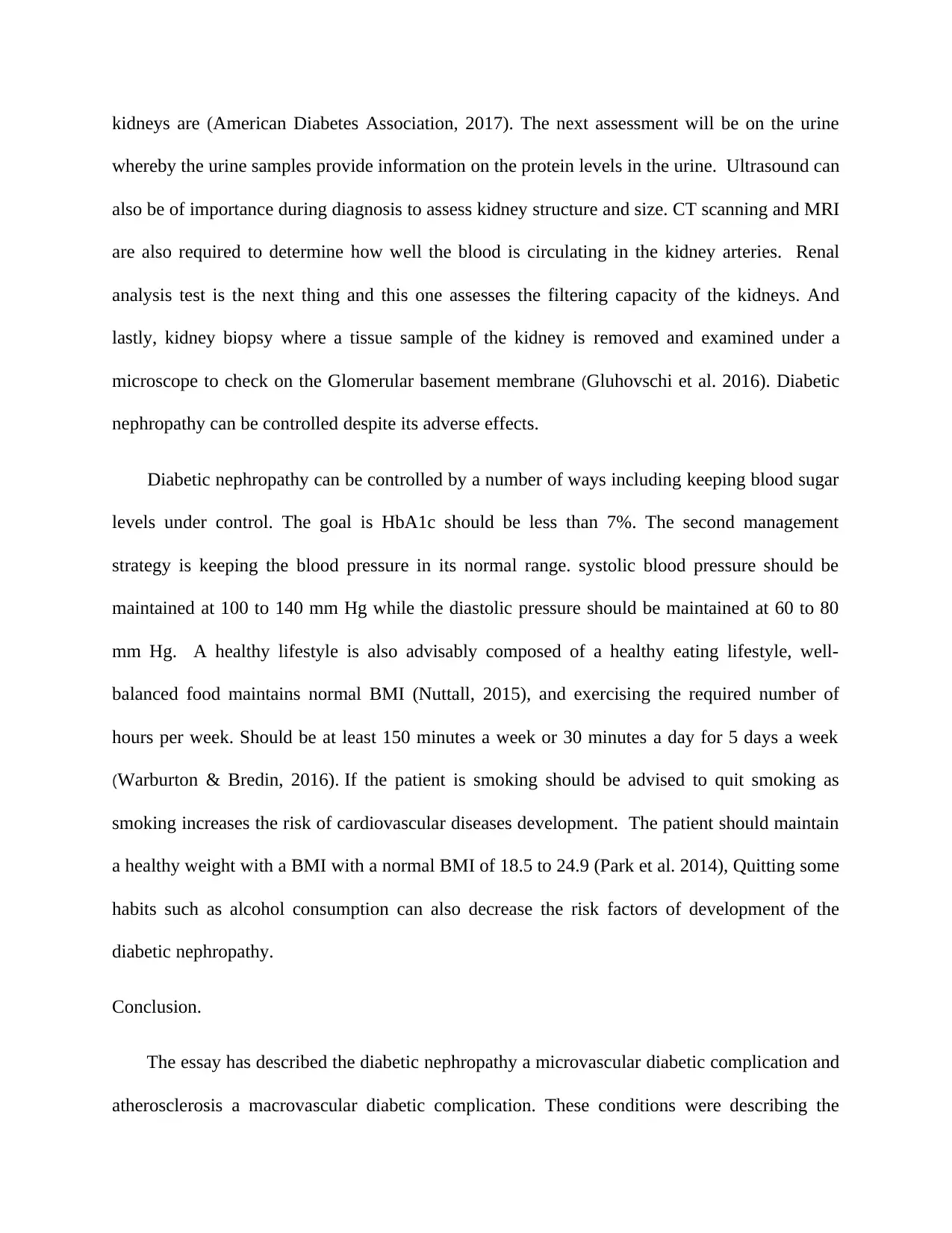
kidneys are (American Diabetes Association, 2017). The next assessment will be on the urine
whereby the urine samples provide information on the protein levels in the urine. Ultrasound can
also be of importance during diagnosis to assess kidney structure and size. CT scanning and MRI
are also required to determine how well the blood is circulating in the kidney arteries. Renal
analysis test is the next thing and this one assesses the filtering capacity of the kidneys. And
lastly, kidney biopsy where a tissue sample of the kidney is removed and examined under a
microscope to check on the Glomerular basement membrane (Gluhovschi et al. 2016). Diabetic
nephropathy can be controlled despite its adverse effects.
Diabetic nephropathy can be controlled by a number of ways including keeping blood sugar
levels under control. The goal is HbA1c should be less than 7%. The second management
strategy is keeping the blood pressure in its normal range. systolic blood pressure should be
maintained at 100 to 140 mm Hg while the diastolic pressure should be maintained at 60 to 80
mm Hg. A healthy lifestyle is also advisably composed of a healthy eating lifestyle, well-
balanced food maintains normal BMI (Nuttall, 2015), and exercising the required number of
hours per week. Should be at least 150 minutes a week or 30 minutes a day for 5 days a week
(Warburton & Bredin, 2016). If the patient is smoking should be advised to quit smoking as
smoking increases the risk of cardiovascular diseases development. The patient should maintain
a healthy weight with a BMI with a normal BMI of 18.5 to 24.9 (Park et al. 2014), Quitting some
habits such as alcohol consumption can also decrease the risk factors of development of the
diabetic nephropathy.
Conclusion.
The essay has described the diabetic nephropathy a microvascular diabetic complication and
atherosclerosis a macrovascular diabetic complication. These conditions were describing the
whereby the urine samples provide information on the protein levels in the urine. Ultrasound can
also be of importance during diagnosis to assess kidney structure and size. CT scanning and MRI
are also required to determine how well the blood is circulating in the kidney arteries. Renal
analysis test is the next thing and this one assesses the filtering capacity of the kidneys. And
lastly, kidney biopsy where a tissue sample of the kidney is removed and examined under a
microscope to check on the Glomerular basement membrane (Gluhovschi et al. 2016). Diabetic
nephropathy can be controlled despite its adverse effects.
Diabetic nephropathy can be controlled by a number of ways including keeping blood sugar
levels under control. The goal is HbA1c should be less than 7%. The second management
strategy is keeping the blood pressure in its normal range. systolic blood pressure should be
maintained at 100 to 140 mm Hg while the diastolic pressure should be maintained at 60 to 80
mm Hg. A healthy lifestyle is also advisably composed of a healthy eating lifestyle, well-
balanced food maintains normal BMI (Nuttall, 2015), and exercising the required number of
hours per week. Should be at least 150 minutes a week or 30 minutes a day for 5 days a week
(Warburton & Bredin, 2016). If the patient is smoking should be advised to quit smoking as
smoking increases the risk of cardiovascular diseases development. The patient should maintain
a healthy weight with a BMI with a normal BMI of 18.5 to 24.9 (Park et al. 2014), Quitting some
habits such as alcohol consumption can also decrease the risk factors of development of the
diabetic nephropathy.
Conclusion.
The essay has described the diabetic nephropathy a microvascular diabetic complication and
atherosclerosis a macrovascular diabetic complication. These conditions were describing the
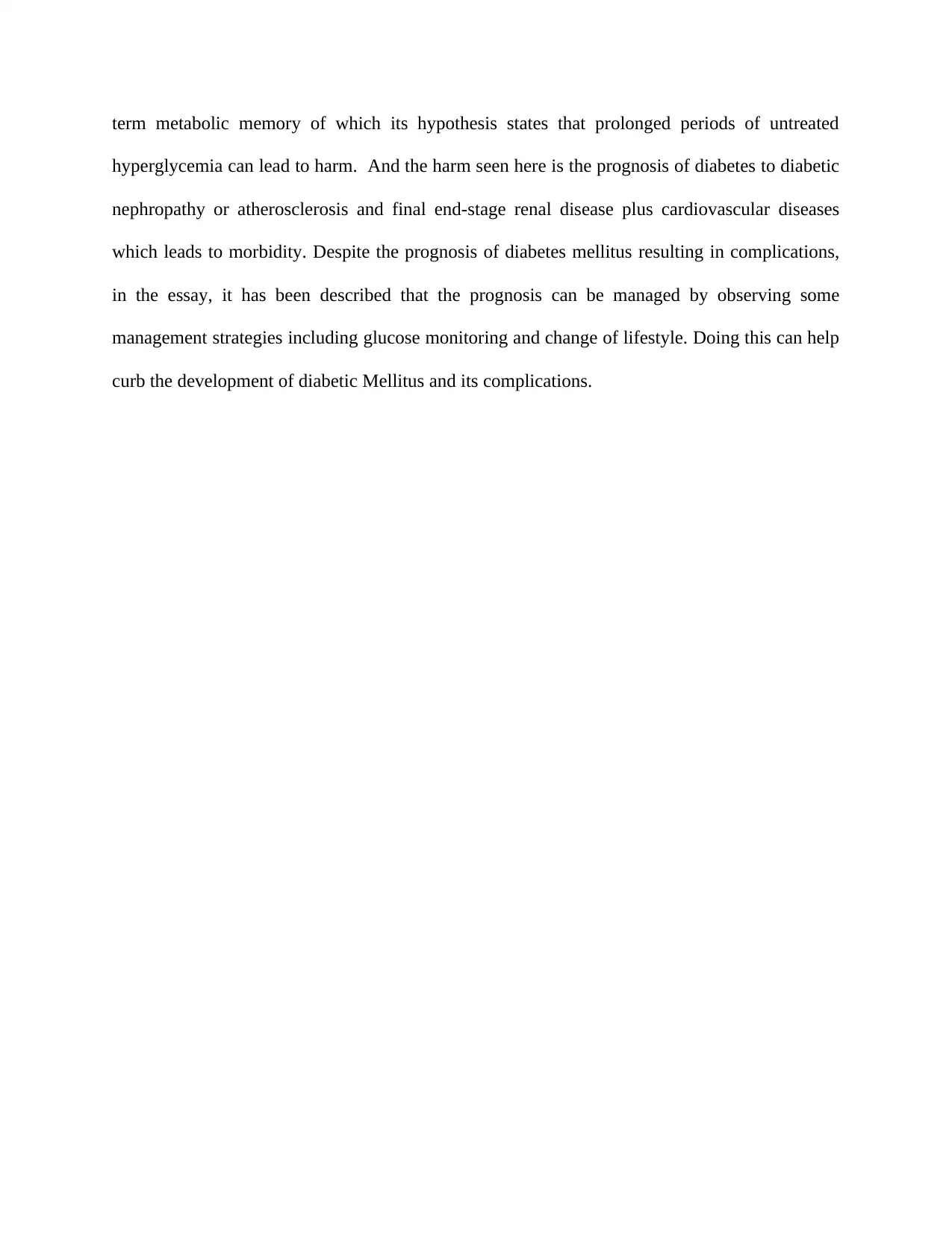
term metabolic memory of which its hypothesis states that prolonged periods of untreated
hyperglycemia can lead to harm. And the harm seen here is the prognosis of diabetes to diabetic
nephropathy or atherosclerosis and final end-stage renal disease plus cardiovascular diseases
which leads to morbidity. Despite the prognosis of diabetes mellitus resulting in complications,
in the essay, it has been described that the prognosis can be managed by observing some
management strategies including glucose monitoring and change of lifestyle. Doing this can help
curb the development of diabetic Mellitus and its complications.
hyperglycemia can lead to harm. And the harm seen here is the prognosis of diabetes to diabetic
nephropathy or atherosclerosis and final end-stage renal disease plus cardiovascular diseases
which leads to morbidity. Despite the prognosis of diabetes mellitus resulting in complications,
in the essay, it has been described that the prognosis can be managed by observing some
management strategies including glucose monitoring and change of lifestyle. Doing this can help
curb the development of diabetic Mellitus and its complications.
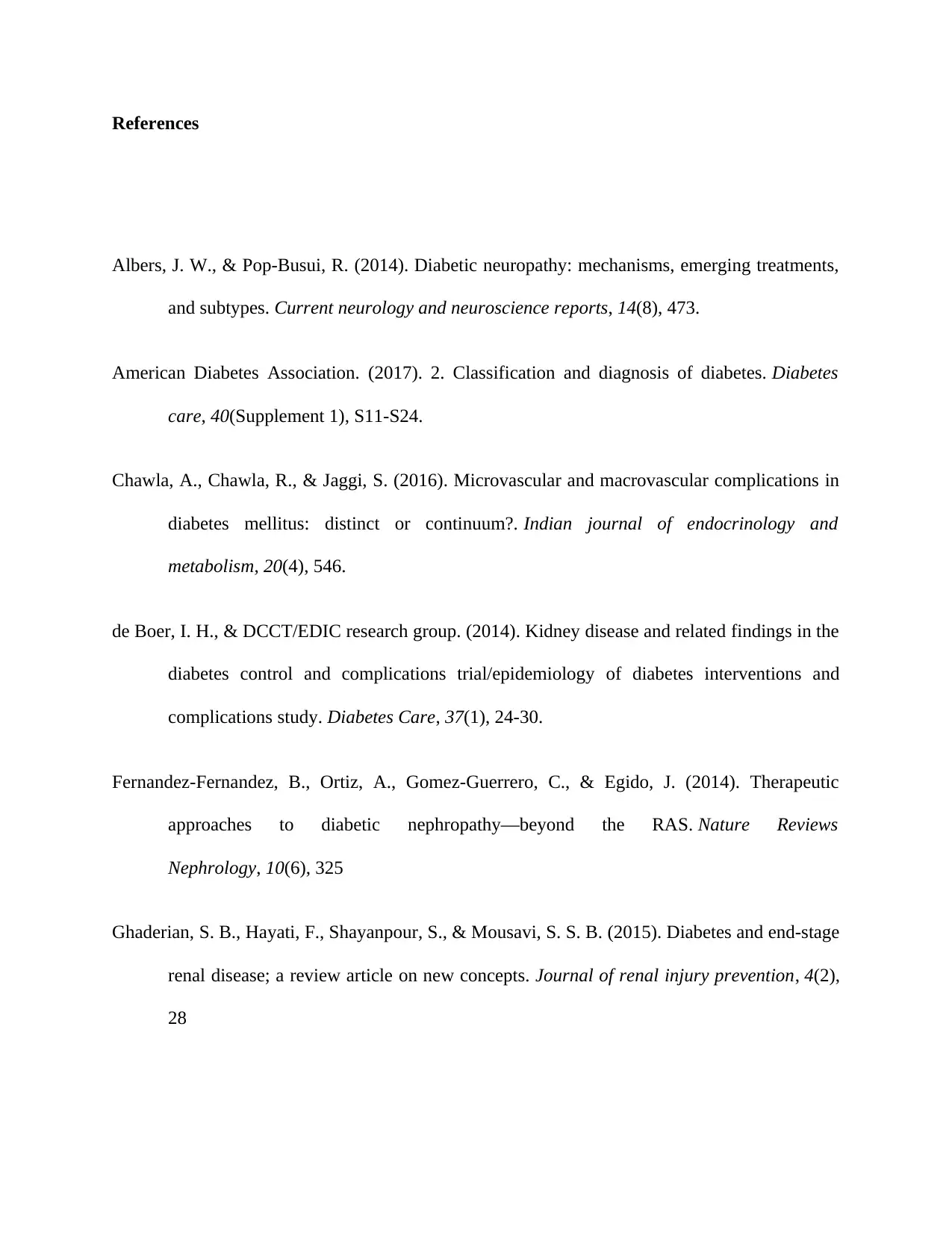
References
Albers, J. W., & Pop-Busui, R. (2014). Diabetic neuropathy: mechanisms, emerging treatments,
and subtypes. Current neurology and neuroscience reports, 14(8), 473.
American Diabetes Association. (2017). 2. Classification and diagnosis of diabetes. Diabetes
care, 40(Supplement 1), S11-S24.
Chawla, A., Chawla, R., & Jaggi, S. (2016). Microvascular and macrovascular complications in
diabetes mellitus: distinct or continuum?. Indian journal of endocrinology and
metabolism, 20(4), 546.
de Boer, I. H., & DCCT/EDIC research group. (2014). Kidney disease and related findings in the
diabetes control and complications trial/epidemiology of diabetes interventions and
complications study. Diabetes Care, 37(1), 24-30.
Fernandez-Fernandez, B., Ortiz, A., Gomez-Guerrero, C., & Egido, J. (2014). Therapeutic
approaches to diabetic nephropathy—beyond the RAS. Nature Reviews
Nephrology, 10(6), 325
Ghaderian, S. B., Hayati, F., Shayanpour, S., & Mousavi, S. S. B. (2015). Diabetes and end-stage
renal disease; a review article on new concepts. Journal of renal injury prevention, 4(2),
28
Albers, J. W., & Pop-Busui, R. (2014). Diabetic neuropathy: mechanisms, emerging treatments,
and subtypes. Current neurology and neuroscience reports, 14(8), 473.
American Diabetes Association. (2017). 2. Classification and diagnosis of diabetes. Diabetes
care, 40(Supplement 1), S11-S24.
Chawla, A., Chawla, R., & Jaggi, S. (2016). Microvascular and macrovascular complications in
diabetes mellitus: distinct or continuum?. Indian journal of endocrinology and
metabolism, 20(4), 546.
de Boer, I. H., & DCCT/EDIC research group. (2014). Kidney disease and related findings in the
diabetes control and complications trial/epidemiology of diabetes interventions and
complications study. Diabetes Care, 37(1), 24-30.
Fernandez-Fernandez, B., Ortiz, A., Gomez-Guerrero, C., & Egido, J. (2014). Therapeutic
approaches to diabetic nephropathy—beyond the RAS. Nature Reviews
Nephrology, 10(6), 325
Ghaderian, S. B., Hayati, F., Shayanpour, S., & Mousavi, S. S. B. (2015). Diabetes and end-stage
renal disease; a review article on new concepts. Journal of renal injury prevention, 4(2),
28
Paraphrase This Document
Need a fresh take? Get an instant paraphrase of this document with our AI Paraphraser
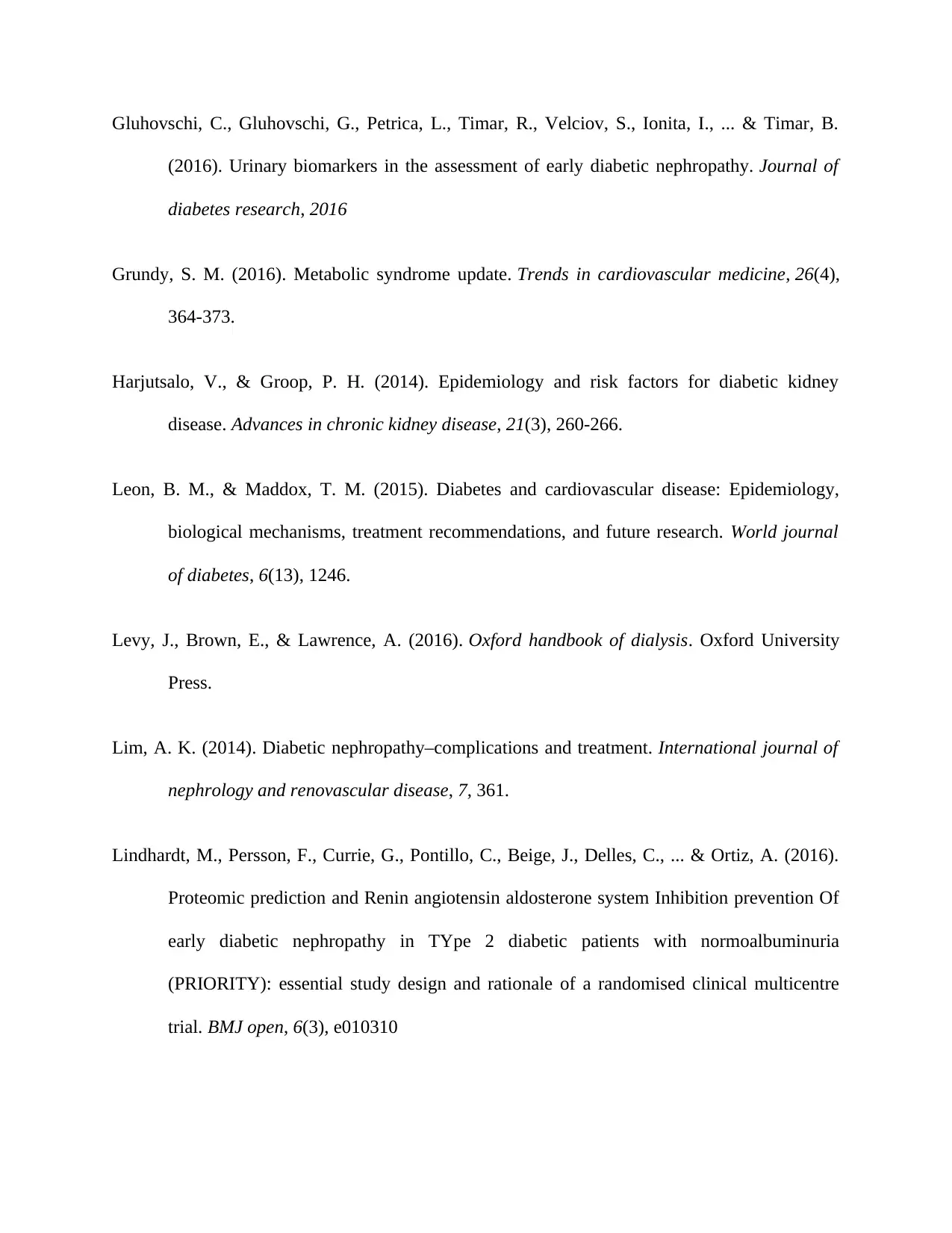
Gluhovschi, C., Gluhovschi, G., Petrica, L., Timar, R., Velciov, S., Ionita, I., ... & Timar, B.
(2016). Urinary biomarkers in the assessment of early diabetic nephropathy. Journal of
diabetes research, 2016
Grundy, S. M. (2016). Metabolic syndrome update. Trends in cardiovascular medicine, 26(4),
364-373.
Harjutsalo, V., & Groop, P. H. (2014). Epidemiology and risk factors for diabetic kidney
disease. Advances in chronic kidney disease, 21(3), 260-266.
Leon, B. M., & Maddox, T. M. (2015). Diabetes and cardiovascular disease: Epidemiology,
biological mechanisms, treatment recommendations, and future research. World journal
of diabetes, 6(13), 1246.
Levy, J., Brown, E., & Lawrence, A. (2016). Oxford handbook of dialysis. Oxford University
Press.
Lim, A. K. (2014). Diabetic nephropathy–complications and treatment. International journal of
nephrology and renovascular disease, 7, 361.
Lindhardt, M., Persson, F., Currie, G., Pontillo, C., Beige, J., Delles, C., ... & Ortiz, A. (2016).
Proteomic prediction and Renin angiotensin aldosterone system Inhibition prevention Of
early diabetic nephropathy in TYpe 2 diabetic patients with normoalbuminuria
(PRIORITY): essential study design and rationale of a randomised clinical multicentre
trial. BMJ open, 6(3), e010310
(2016). Urinary biomarkers in the assessment of early diabetic nephropathy. Journal of
diabetes research, 2016
Grundy, S. M. (2016). Metabolic syndrome update. Trends in cardiovascular medicine, 26(4),
364-373.
Harjutsalo, V., & Groop, P. H. (2014). Epidemiology and risk factors for diabetic kidney
disease. Advances in chronic kidney disease, 21(3), 260-266.
Leon, B. M., & Maddox, T. M. (2015). Diabetes and cardiovascular disease: Epidemiology,
biological mechanisms, treatment recommendations, and future research. World journal
of diabetes, 6(13), 1246.
Levy, J., Brown, E., & Lawrence, A. (2016). Oxford handbook of dialysis. Oxford University
Press.
Lim, A. K. (2014). Diabetic nephropathy–complications and treatment. International journal of
nephrology and renovascular disease, 7, 361.
Lindhardt, M., Persson, F., Currie, G., Pontillo, C., Beige, J., Delles, C., ... & Ortiz, A. (2016).
Proteomic prediction and Renin angiotensin aldosterone system Inhibition prevention Of
early diabetic nephropathy in TYpe 2 diabetic patients with normoalbuminuria
(PRIORITY): essential study design and rationale of a randomised clinical multicentre
trial. BMJ open, 6(3), e010310
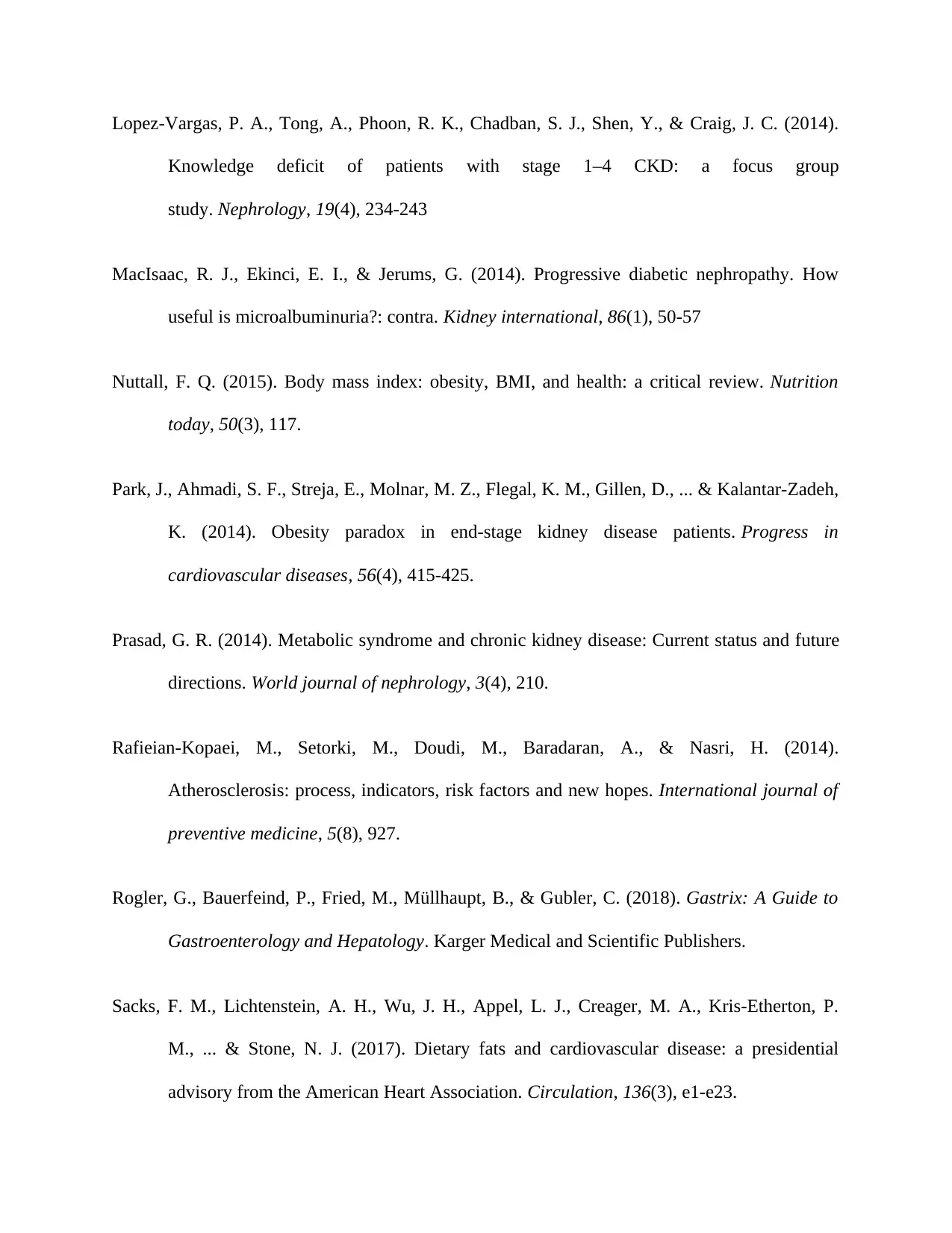
Lopez‐Vargas, P. A., Tong, A., Phoon, R. K., Chadban, S. J., Shen, Y., & Craig, J. C. (2014).
Knowledge deficit of patients with stage 1–4 CKD: a focus group
study. Nephrology, 19(4), 234-243
MacIsaac, R. J., Ekinci, E. I., & Jerums, G. (2014). Progressive diabetic nephropathy. How
useful is microalbuminuria?: contra. Kidney international, 86(1), 50-57
Nuttall, F. Q. (2015). Body mass index: obesity, BMI, and health: a critical review. Nutrition
today, 50(3), 117.
Park, J., Ahmadi, S. F., Streja, E., Molnar, M. Z., Flegal, K. M., Gillen, D., ... & Kalantar-Zadeh,
K. (2014). Obesity paradox in end-stage kidney disease patients. Progress in
cardiovascular diseases, 56(4), 415-425.
Prasad, G. R. (2014). Metabolic syndrome and chronic kidney disease: Current status and future
directions. World journal of nephrology, 3(4), 210.
Rafieian-Kopaei, M., Setorki, M., Doudi, M., Baradaran, A., & Nasri, H. (2014).
Atherosclerosis: process, indicators, risk factors and new hopes. International journal of
preventive medicine, 5(8), 927.
Rogler, G., Bauerfeind, P., Fried, M., Müllhaupt, B., & Gubler, C. (2018). Gastrix: A Guide to
Gastroenterology and Hepatology. Karger Medical and Scientific Publishers.
Sacks, F. M., Lichtenstein, A. H., Wu, J. H., Appel, L. J., Creager, M. A., Kris-Etherton, P.
M., ... & Stone, N. J. (2017). Dietary fats and cardiovascular disease: a presidential
advisory from the American Heart Association. Circulation, 136(3), e1-e23.
Knowledge deficit of patients with stage 1–4 CKD: a focus group
study. Nephrology, 19(4), 234-243
MacIsaac, R. J., Ekinci, E. I., & Jerums, G. (2014). Progressive diabetic nephropathy. How
useful is microalbuminuria?: contra. Kidney international, 86(1), 50-57
Nuttall, F. Q. (2015). Body mass index: obesity, BMI, and health: a critical review. Nutrition
today, 50(3), 117.
Park, J., Ahmadi, S. F., Streja, E., Molnar, M. Z., Flegal, K. M., Gillen, D., ... & Kalantar-Zadeh,
K. (2014). Obesity paradox in end-stage kidney disease patients. Progress in
cardiovascular diseases, 56(4), 415-425.
Prasad, G. R. (2014). Metabolic syndrome and chronic kidney disease: Current status and future
directions. World journal of nephrology, 3(4), 210.
Rafieian-Kopaei, M., Setorki, M., Doudi, M., Baradaran, A., & Nasri, H. (2014).
Atherosclerosis: process, indicators, risk factors and new hopes. International journal of
preventive medicine, 5(8), 927.
Rogler, G., Bauerfeind, P., Fried, M., Müllhaupt, B., & Gubler, C. (2018). Gastrix: A Guide to
Gastroenterology and Hepatology. Karger Medical and Scientific Publishers.
Sacks, F. M., Lichtenstein, A. H., Wu, J. H., Appel, L. J., Creager, M. A., Kris-Etherton, P.
M., ... & Stone, N. J. (2017). Dietary fats and cardiovascular disease: a presidential
advisory from the American Heart Association. Circulation, 136(3), e1-e23.
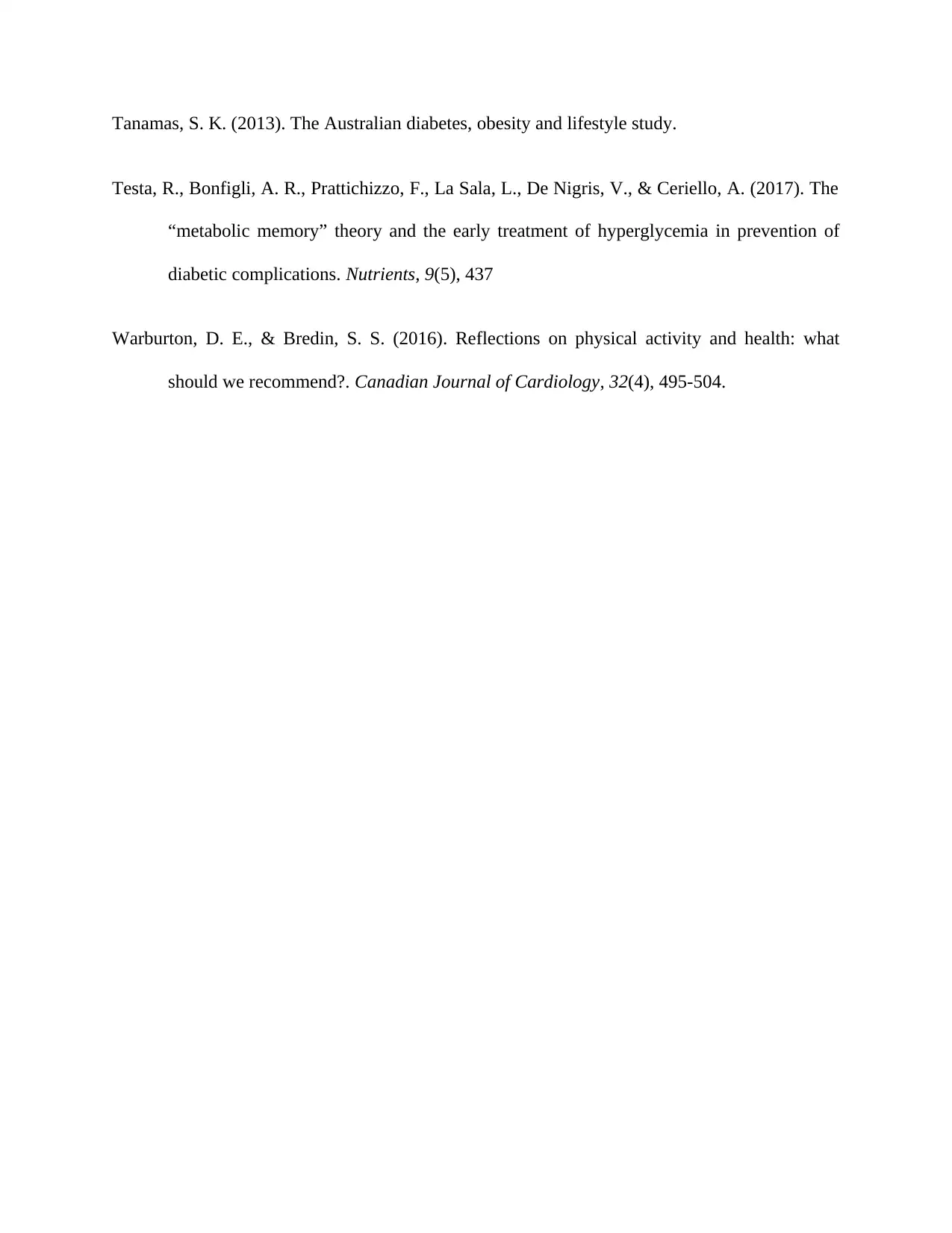
Tanamas, S. K. (2013). The Australian diabetes, obesity and lifestyle study.
Testa, R., Bonfigli, A. R., Prattichizzo, F., La Sala, L., De Nigris, V., & Ceriello, A. (2017). The
“metabolic memory” theory and the early treatment of hyperglycemia in prevention of
diabetic complications. Nutrients, 9(5), 437
Warburton, D. E., & Bredin, S. S. (2016). Reflections on physical activity and health: what
should we recommend?. Canadian Journal of Cardiology, 32(4), 495-504.
Testa, R., Bonfigli, A. R., Prattichizzo, F., La Sala, L., De Nigris, V., & Ceriello, A. (2017). The
“metabolic memory” theory and the early treatment of hyperglycemia in prevention of
diabetic complications. Nutrients, 9(5), 437
Warburton, D. E., & Bredin, S. S. (2016). Reflections on physical activity and health: what
should we recommend?. Canadian Journal of Cardiology, 32(4), 495-504.
1 out of 16
Related Documents
Your All-in-One AI-Powered Toolkit for Academic Success.
+13062052269
info@desklib.com
Available 24*7 on WhatsApp / Email
![[object Object]](/_next/static/media/star-bottom.7253800d.svg)
Unlock your academic potential
© 2024 | Zucol Services PVT LTD | All rights reserved.





